Activity Report
Report on Activities from April 2013 to March 2014
2 Daikin Projects Making Good Progress
Project to Restore Japanese Judas Trees and Life-Giving River
New Fence Built Along Iwaobetsu River
In the summer of 2013, work began on a new fence along the Iwaobetsu River. The fence is to help the forest grow by preventing Sika deer from eating saplings. Fences over the last two years had been constructed in a riparian forest that had been left in relatively good condition, and this year a fence is finally being built along the river.
In mid-November 2013, a large number of volunteers including Daikin employees completed a fence more than 3 meters high and approximately 270 meters long. Starting in the spring of 2014, Japanese Judas tree seedlings that have been carefully nurtured are being planted within the fenced area.
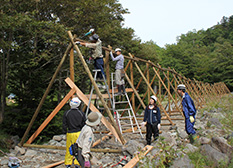 Daikin employees and other volunteers erected
a new fence
Daikin employees and other volunteers erected
a new fence
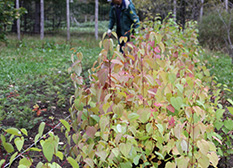 Planting of Japanese Judas tree
seedlings began in the spring of 2014
Planting of Japanese Judas tree
seedlings began in the spring of 2014
Recording Changes in the Condition of the River While Returning It to Its Natural State
In the spring of 2013, surveying work, including using a motorized paraglider to take aerial images, was done along the river. Besides being used to help in planning restoration work, this information was used to compare the state of the river before and after restoration work.
In July, construction machinery was used to place rocks in three locations along the upstream and midstream sections of the river. The river had strayed from its original path, and the rocks were to center the river channel. Although heavy rains in October and November carried away some of these rocks, fortunately the river was able to be diverted to within the path intended by this restoration work, and it is apparent that the river environment is gradually improving.
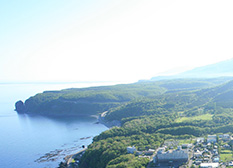 River flow was studied by taking
images from a motorized paraglider
River flow was studied by taking
images from a motorized paraglider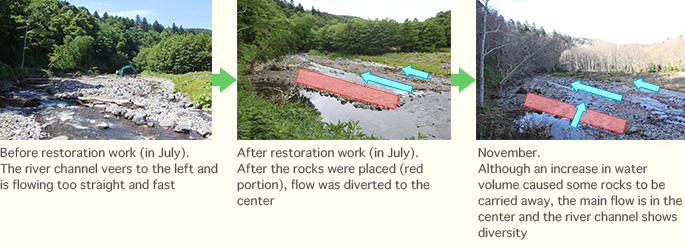
Fish Such as Salt-Water Trout and Cherry Trout Discovered Living Upstream
In 2013, in addition to a survey of fish living in the Iwaobetsu River, a survey was also done on the upstream side of a dam in the upper river basin of the Iwaobetsu River. This dam is almost three meters high, so its upstream side was isolated since fish could not get past it to go upstream.
But the survey discovered that even in such an isolated environment there are fish such as salt-water trout, as well as cherry trout that had been released there in the past.
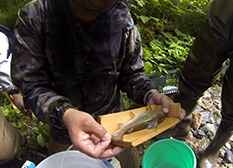 After fish are measured, they are
immediately released back into the river
After fish are measured, they are
immediately released back into the riverProject to Promote Human-Brown Bear Coexistence in Shiretoko
Electric Fence Extended, Motion Sensor Cameras Set Up to Gauge Effectiveness
To separate the habitats of brown bears and humans, an electric fence with an electrical charge just strong enough to startle the bears was constructed. In October 2013, this electric fence was extended to the north and south by a total distance of 2.1 kilometers: from the Kikiribetsu district stretching along the right bank of the Rusa River, and from the kelp-drying beach to the Aidomari district. To aid in an experiment to understand the fence's effectiveness, motion sensor cameras were placed at four locations along the fence. The data gathered is expected to help make the fence a more effective measure.
In early December, leaflets describing electric fence construction and its effectiveness were distributed to 78 households involved in kelp harvesting and set net fishery operators along the electric fence. The leaflets requested the understanding and cooperation of locals and described things like fence location, a decrease in sightings of bears and deer since it was erected, and precautions to take regarding the fence itself.
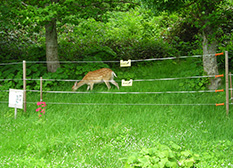 Deer eats grass near the electric fence
Deer eats grass near the electric fenceBears Lifestyle Gradually Coming Into Focus
In June 2013, a new survey got underway using automated cameras and hair traps to collect images and DNA samples of bears, an animal rarely seen close up by humans. Bears are lured close to the cameras by the smell of deer meat hanging from trees, and when they step over low barbed wire fences around the perimeter they trigger camera operation. Bear hair caught on the barbed wire is used to extract DNA samples. This survey confirmed the existence in the area of eight males and one female, all previously unknown.
As a result of the many tests conducted on samples collected during this and previous surveys, it was discovered that dominant males move over a wide area of the peninsula and have fathered many cubs in various locations, and that at a young age males often move from their birthplace to somewhere else and die there.
This was one of the few examples worldwide of successful research that includes bears' genetic information. The collection of DNA samples from so many individual bears is expected to answer questions regarding the blood relations and social structure of brown bears living in the Rusha district.
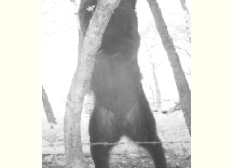 This brown bear, estimated to weigh
over 300 kilograms, was filmed with an automated camera
This brown bear, estimated to weigh
over 300 kilograms, was filmed with an automated cameraFor First Time in Japan, Bears Taken Alive with Tranquilizer Guns and Affixed with GPS Tracking Devices
What are bears movement patterns throughout the year in the Rusha district? The answer to this question could help in creating measures to avoid unpleasant encounters between bears and humans. But this mystery cannot be solved through only DNA analysis and bear observations. It was therefore decided to capture bears and affix to them GPS tracking devices not unlike GPS car navigation systems.
In June 2013, a two-year-old male named Beeko was captured using a tranquilizer gun. Capturing a wild bear with a tranquilizer gun was considered extremely difficult; in fact, this was the first time it had ever been done in Japan. The GPS tracking device attached to the bear records location information once every hour.
This information told researchers that Beeko moves around mainly in the vicinity of the Ubushinotta River, slightly to the north of the Rusha district, occasionally venturing into the Rusha district.
This tracking work will continue so that researchers can determine the bears' pattern of movement.
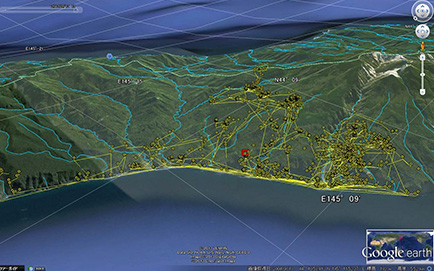 Map showing Beeko's tracks over the summer
Map showing Beeko's tracks over the summer
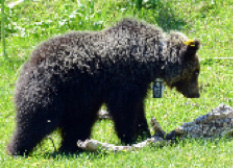 A GPS tracking device was attached
to Beeko's neck to enable researchers to follow his path
A GPS tracking device was attached
to Beeko's neck to enable researchers to follow his path
Note: The photos on this website are courtesy of the Shiretoko Nature Foundation.









